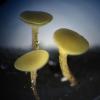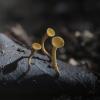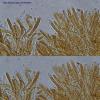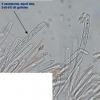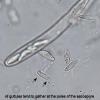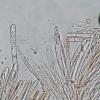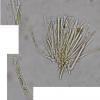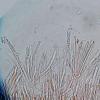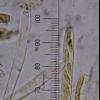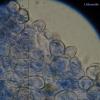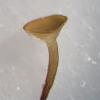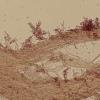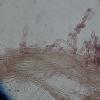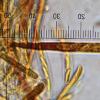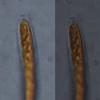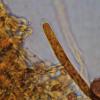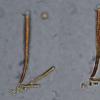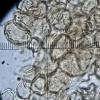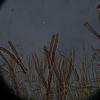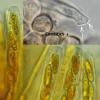
30-12-2025 16:44
Pascal DucosBonjour,Une anamorphe rose stipitée, très nombre

30-12-2025 17:14
 Bernard CLESSE
Bernard CLESSE
Bonjour à toutes et tous,Pourriez-vous aider Albe

29-12-2025 10:15
Hulda Caroline HolteHello, I found and collected this propoloid ascom

30-12-2025 09:04
Hello.A Pyrenomycete sprouting sparsely but very d

29-12-2025 17:44
Isabelle CharissouBonjour,J'aimerais savoir si d'autres personnes au

12-11-2021 00:03
Lepista ZacariasHi everybody,A week ago in my fiels trip I noticed

29-12-2025 17:12
 Bernard CLESSE
Bernard CLESSE
Bonjour à toutes et tous,Pourriez-vous m'aider à
 Small, 2-8mm diameter ascocarp, yellow-honey, almost flat, with a smooth glabrous margin, stipe 2-3(4) times the diameter of cup, growing on fallen leaves of Ceratonia siliqua, usually in groups, but not in tufted clusters
Small, 2-8mm diameter ascocarp, yellow-honey, almost flat, with a smooth glabrous margin, stipe 2-3(4) times the diameter of cup, growing on fallen leaves of Ceratonia siliqua, usually in groups, but not in tufted clusters Asci slender, J-ve with Melzer, but a faint blue lining with Lugols on apex. Sealed, without operculum, spores released through a pore which becomes outrolled like a roman vase when ascus is empty. 8 ascospores per ascus, compact, diagonally packed around each other.
Ascospores spindle shaped, slender, not septate, with 3-6(8+) small oil bodies that tend to gather at the poles of the spindle shaped spore.
When I applied KOH on the ascocarp, it became duller (greyish yellow) but no red tonality. Perhaps insignificant.
Micro:
Spore length range: 7.5 - 11.31 µm
Spore length mean: 9.6 µm
Spore width range: 2 - 3 µm
Spore width mean: 2.6 µm
Spore Q factor range: 3.19 - 4.52 µm
Spore Q factor mean: 3.68
Spore shape: Spindle, slender
Spore septa: 0 (no speta)
Spore surface: Smooth
Ascum average size: 75 µm x 6.3 µm
Iodine reaction: J -ve (faint blue apical lining with Lugol's Iodine)

wellcome to the forum!
your fungus is very interesting. It is surely the species that also Raul Tena collected on Ceratonia leaves. We have it in the genus Moellerodiscus and the species M. lentus in a wide sense. That species is an aggregate, however, and contains perhaps some host-specific taxa.
What you need to clarify is the ascus base for croziers. Raul's sample has asci without croziers though sometimes with a protuberance at the ascus base that does not fuse with the cell below, whereas what we think is typical M. lentus has croziers.
Also Raul's has a more distinct amyloid reaction of the apical ring. Maybe you succeed with a sharper closeup of the ascus apex in Lugol? or you could test KOH-pretreated asci (remove the KOH with water before applying iodine).
If anybody has the opportunity to sequence apothecia (sorry when I mention this too often), this genus is so far unsequenced at all. There is one species in genBank but this falls near Rutstroemia where I would never expect Moellerodiscus.
Zotto

Yes, I agree with Zotto. Here the message where I posted my macro/micro phots of this species (at the bottom of the post):
http://www.ascofrance.fr/search_forum/13919
We usually find it on fruits, very rarely on leaves or twigs. Also colours seem to be different, yours more yellowish. I have only seen this colour in young apothecia, but it is rare.
After your micro photos, it seems not to have croziers, but this needs to be checked.
Is there any chance you can send me some apos?
Thanks in advance,
Raúl

http://www.ascofrance.fr/forum/new/parent_id/34675/ref_id/34712 (taken in situ with natural light) rather than the yellowish one (taken in studio with fluorescent light). I don't think that I have seen croziers, but I am not trained of how they look. It seemed tha the asci had some branching structures at the base, which might as well represent formation of new asci.
I have collected ascocarps and will be happpy to send you some. However you have to intstruct me how they must be sent/packed (Dry or wet?). I am happy to contribute for anything of scientific publication.

Yes, I made a mistake of mounting the Lugol's Iodine stained specimen in KOH. That might have decolrised the blue stain. I will in the coming days prepare another section and micrograph to remove any doubt.

Just to check the procedure is standardised:
1) Put section (living) in KOH for 1-2mins
2) Clean in water
3) Immerse in Lugol's Iodine
4) Gently heat slide with small flame (Lighter) and allow to cool (1-2mins)
5) Wash and mount in water
P.s. Do I need to perform steps 1 and 2 on living material?
=======
Justo para verificar el procedimiento es normalizado (estandardizado):
1) Sección Puesta (viviente) en KOH para 1-2mins
2) Limpio en agua
3) Sumergir en el Yodo de Lugol
4) Caliente despacio la diapositiva (resbalón) con la pequeña llama (más ligera) y permita enfriarse (1-2mins
5) Lavado y monte (soporte) en agua
¿ P.s. debo ejecutar pasos (etapas 1 y 2) en vida el material (la materia(asignatura))?

In order to test hemiamyloidity you should check the asci tips first in IKI (Lugol), then add KOH and finally IKI again.
Here the steps I suggest:
1) Make a mount of living material directly in tap water without any pre-treatment.
2) Add IKI (placing a small drop next to the border of the preparation and let it spread across the slide) and then look for the reaction in the asci tips. If hemiamyloid, then you should see a dirty reddish after a blue reaction (or directly red, but in this species I do not expect this case). If euamyloid, then you will only get the blue reaction. Your IKI must have a good concentration of iodine, more or less 0,3-0,5%.
3) Add KOH (3-5 %), then the asci tips reaction will disappear.
4) Remove the KOH with water.
5) Add IKI again. Then you will only have a blue reaction where you before got a reddish reaction.
If you only want to check amyloidity in a wide sense, then you can pre-treat with KOH and afterwards add IKI. I think that was what Zotto meant in order to see clearly which was the type of asci you had, if Sclerotinia type or not. The shape of the reaction is not so clear as in others members of the Sclerotiniaceae, in Moellerodiscus it is weaker.
This evening I will send you an e-mail telling you how to make the shipment, but there is no need to be fresh, just let the sample dry at room temperature.
Thanks for your collaboration!
Raúl

1) Are Steps 3,4 and 5 done at the side of the coverslip while the specimen is mounted (squashed). I think so, but wanted to be sure. Possibly a filter paper at the other side of the coverslip will speed the diffusion and replacement of liquids.
2) Does the reaction takes place on dead asci, that is empty asci that have released their spores?
Thanks

2) The reaction takes place in living asci, dead asci or in asci that have already released their spores. Only you won´t see it in immature asci. But it is better seen in dead asci that haven´t shot the ascospores because the apical ring is intact.
Cheers,
Raúl

I am not sure, but are we thinking that the species is M. lentus or something else.

If I am right then it could well be M. lentus. But I fear nobody tested the type sample for croziers so far (?).
zotto@arcor.de

See p. 251, Mycologia 68. The Ceilan sample is among the many samples he studied He states croziers (p.249) .

1. he studied a huge amount of collections, so how often did he see the croziers and in which material?
2. he did not figure the structure
3. Dumont's statements about croziers are not trustful. In my paper on H. serotinus I wrote about this:
"Dumont is apparently
in error when stating that they are produced from small
croziers: according to DUMONT & CARPENTER (1982), the asci in all of
their tropical collections of the seven species treated are said to arise
from croziers, including H. caudatus, for which the authors report a
high number of collections on leaves (rarely herbaceous stems) from
tropical America. Since H. caudatus was found to lack croziers in
most of the European as well as North American specimens (WHITE,
1943: 151; BARAL, ined.), and DUMONT & CARPENTER (loc. cit.) did not il-
lustrate the feature in any of their drawings, their descriptions seem
to be untrustworthy in this respect, at least this is obvious in the
above-mentioned H. fastidiosus."
Zotto

Anyway, I created a zip file with all my images and can be downloaded from here:
www.maltawildplants.com/!up/Moellerodiscus_lentus.zipx
Sample dried and soon on its way Raul. If interested I have few more left in the fridge

It would be great if you could restudy the type searching for croziers! ;-)
Maybe even Dumont left some slide where this could be "easily" checked.
I´ve received Sthephen´s sample and I confirm croziers and a weak euamyloid rection of the apical ring.
Raúl


I have to say that it is still very difficult to spot croziers, but I'll try to learn. Given that the picture is almost complete, what should the specimen be labelled? Moellerodiscus lentus, M. lentus s.l., M. lentus subsp. xxx, or M. lentus subsp. nova ? I gather that for the latter, we need to examine the type so for the moment it would be one of the first three options.
Let me know please!

Stephen

Zotto

http://www.ascofrance.fr/forum?page=1&id=46749



